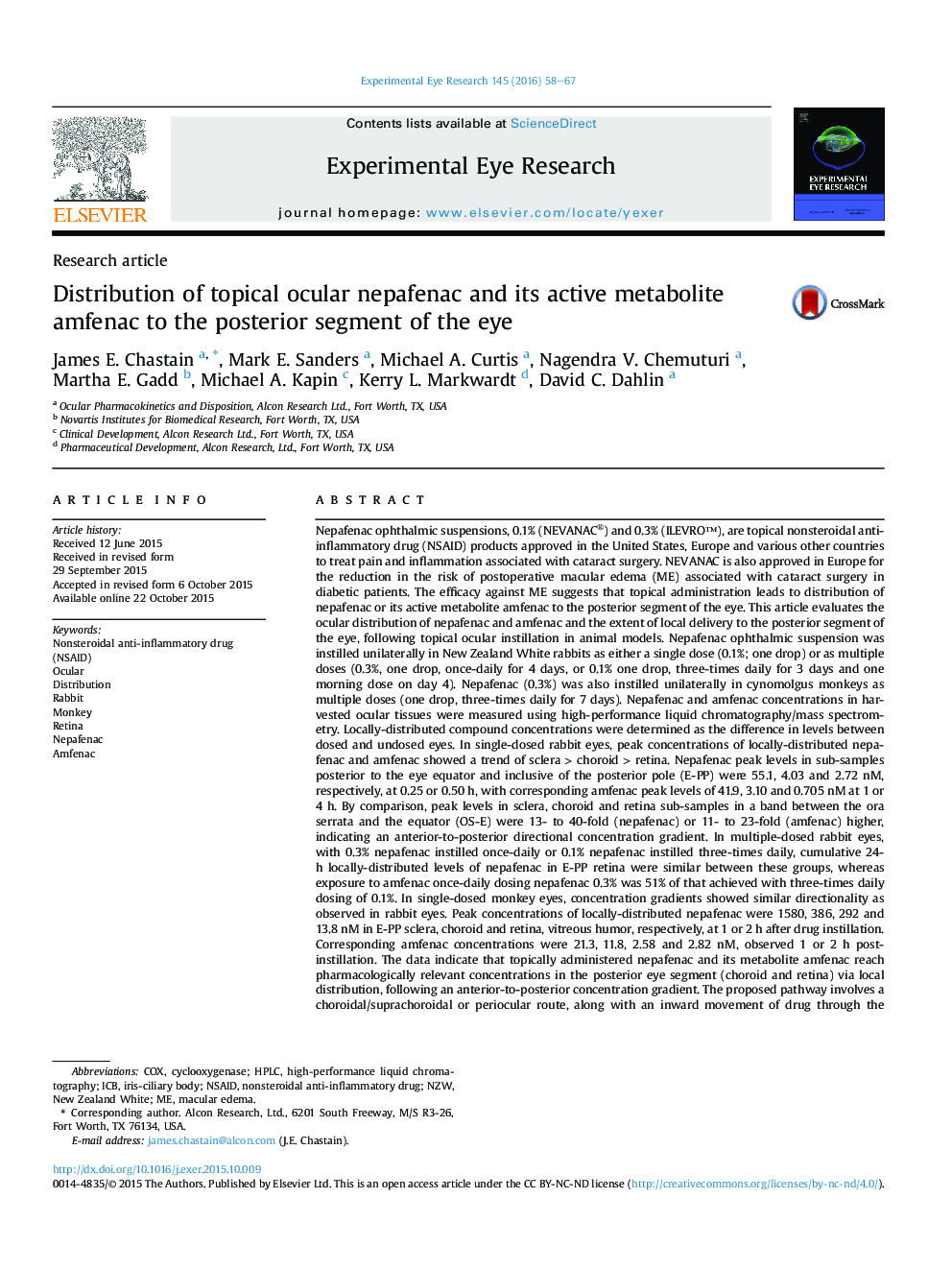| کد مقاله | کد نشریه | سال انتشار | مقاله انگلیسی | نسخه تمام متن |
|---|---|---|---|---|
| 6196445 | 1602577 | 2016 | 10 صفحه PDF | دانلود رایگان |
- Nepafenac and amfenac distribution to the posterior segment of the eye was studied.
- Topical ocular nepafenac instillation took place in both rabbit and monkey models.
- Relevant nepafenac and amfenac concentrations were seen in the choroid and retina.
- Nepafenac and amfenac were available to the posterior segment by local distribution.
- A transconjunctival/scleral route of absorption for drug transfer is proposed.
Nepafenac ophthalmic suspensions, 0.1% (NEVANAC®) and 0.3% (ILEVROâ¢), are topical nonsteroidal anti-inflammatory drug (NSAID) products approved in the United States, Europe and various other countries to treat pain and inflammation associated with cataract surgery. NEVANAC is also approved in Europe for the reduction in the risk of postoperative macular edema (ME) associated with cataract surgery in diabetic patients. The efficacy against ME suggests that topical administration leads to distribution of nepafenac or its active metabolite amfenac to the posterior segment of the eye. This article evaluates the ocular distribution of nepafenac and amfenac and the extent of local delivery to the posterior segment of the eye, following topical ocular instillation in animal models. Nepafenac ophthalmic suspension was instilled unilaterally in New Zealand White rabbits as either a single dose (0.1%; one drop) or as multiple doses (0.3%, one drop, once-daily for 4 days, or 0.1% one drop, three-times daily for 3 days and one morning dose on day 4). Nepafenac (0.3%) was also instilled unilaterally in cynomolgus monkeys as multiple doses (one drop, three-times daily for 7 days). Nepafenac and amfenac concentrations in harvested ocular tissues were measured using high-performance liquid chromatography/mass spectrometry. Locally-distributed compound concentrations were determined as the difference in levels between dosed and undosed eyes. In single-dosed rabbit eyes, peak concentrations of locally-distributed nepafenac and amfenac showed a trend of sclera > choroid > retina. Nepafenac peak levels in sub-samples posterior to the eye equator and inclusive of the posterior pole (E-PP) were 55.1, 4.03 and 2.72 nM, respectively, at 0.25 or 0.50 h, with corresponding amfenac peak levels of 41.9, 3.10 and 0.705 nM at 1 or 4 h. By comparison, peak levels in sclera, choroid and retina sub-samples in a band between the ora serrata and the equator (OS-E) were 13- to 40-fold (nepafenac) or 11- to 23-fold (amfenac) higher, indicating an anterior-to-posterior directional concentration gradient. In multiple-dosed rabbit eyes, with 0.3% nepafenac instilled once-daily or 0.1% nepafenac instilled three-times daily, cumulative 24-h locally-distributed levels of nepafenac in E-PP retina were similar between these groups, whereas exposure to amfenac once-daily dosing nepafenac 0.3% was 51% of that achieved with three-times daily dosing of 0.1%. In single-dosed monkey eyes, concentration gradients showed similar directionality as observed in rabbit eyes. Peak concentrations of locally-distributed nepafenac were 1580, 386, 292 and 13.8 nM in E-PP sclera, choroid and retina, vitreous humor, respectively, at 1 or 2 h after drug instillation. Corresponding amfenac concentrations were 21.3, 11.8, 2.58 and 2.82 nM, observed 1 or 2 h post-instillation. The data indicate that topically administered nepafenac and its metabolite amfenac reach pharmacologically relevant concentrations in the posterior eye segment (choroid and retina) via local distribution, following an anterior-to-posterior concentration gradient. The proposed pathway involves a choroidal/suprachoroidal or periocular route, along with an inward movement of drug through the sclera, choroid and retina, with negligible vitreal compartment involvement. Sustained high nepafenac concentrations in posterior segment tissues may be a reservoir for hydrolysis to amfenac.
Journal: Experimental Eye Research - Volume 145, April 2016, Pages 58-67
